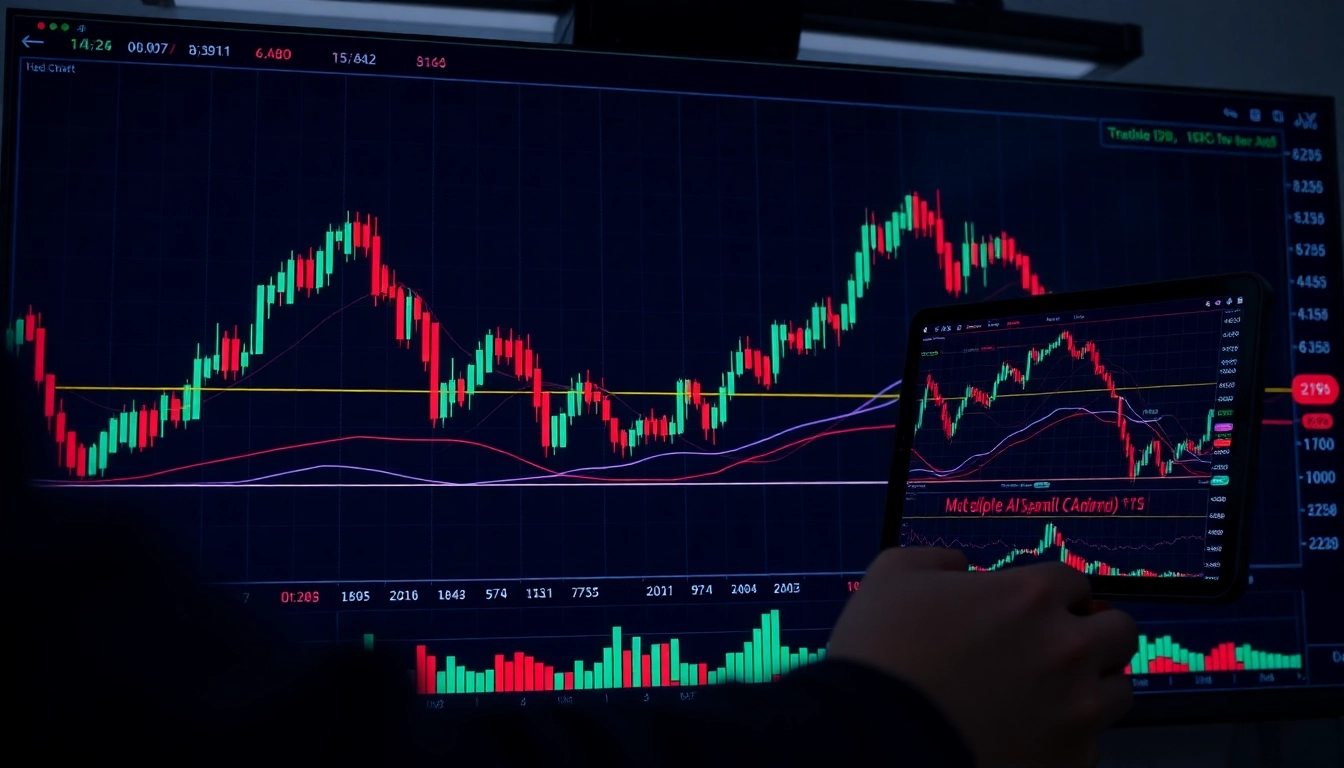Understanding the Basics of Trading View
What is Trading View and How It Works
Trading View is a comprehensive web-based charting platform designed to cater to traders and investors across all levels of expertise. It serves as a hub for technical analysis, market insights, and social interaction within the trading community. The platform integrates real-time data feeds from global markets, allowing users to visualize price movements, identify trends, and execute informed trading strategies. Unlike traditional trading software, Trading View combines powerful charting tools with social features, enabling users to share ideas, follow expert traders, and participate in collaborative analysis.
At its core, Trading View operates by aggregating data from multiple exchanges and financial institutions, providing a real-time, synchronized view of various assets such as stocks, cryptocurrencies, forex pairs, commodities, and indices. Its cloud-based architecture ensures accessibility from any device with internet connectivity, whether a desktop, tablet, or smartphone. With features like custom watchlists, alerts, and scripting capabilities via Pine Script, Trading View empowers traders to tailor their workspace to their unique analytical needs.
For those seeking a robust platform that facilitates both individual analysis and community engagement, trading view offers an all-in-one solution that is widely trusted by millions worldwide.
Key Features and Tools for Beginners
Trading View is renowned for its user-friendly interface and an extensive suite of features that accommodate beginners. These include intuitive charting tools, a wide array of technical indicators such as Moving Averages, RSI, Bollinger Bands, and MACD, alongside a vast library of pre-built scripts and custom indicators. The platform also offers drawing tools for trend lines, Fibonacci retracements, and pattern recognition, enabling new traders to grasp technical analysis concepts effectively.
Additionally, Trading View provides educational resources, webinars, and a community forum where novices can learn by observing seasoned traders’ analysis. Its customizable watchlists allow users to track multiple assets simultaneously, set price alerts for specific levels, and monitor market movements proactively. Integrating social functionalities—such as posting ideas and participating in discussions—encourages collaborative learning among beginners and experienced traders alike.
These features make Trading View an ideal starting point for newcomers eager to understand market dynamics and develop their trading skills with confidence.
Setting Up Your Trading View Account
Establishing a Trading View account is straightforward and can be completed within minutes. First, visit the official website and sign up using an email address or existing social media accounts like Google or Facebook. Once registered, users can navigate to the workspace and customize their profile, setting preferences for chart themes, timeframes, and default indicators.
To optimize your experience, consider exploring the platform’s free subscription plan, which offers essential features suitable for beginners. However, paid tiers provide additional benefits such as multiple chart layouts, more alerts, and advanced data access, beneficial for active traders. The platform also supports seamless integration with brokerage accounts, allowing for direct trading from the platform, further streamlining your workflow.
Trading View’s user onboarding includes guided tutorials and a comprehensive help center, ensuring users can efficiently set up and start analyzing markets without hassle.
Advanced Techniques for Effective Market Analysis
Utilizing Technical Indicators and Chart Patterns
Advanced traders leverage a combination of technical indicators and chart patterns to refine their analysis and improve trade accuracy. Indicators such as Fibonacci retracements help identify key support and resistance levels, while oscillators like Stochastic or RSI can signal overbought or oversold conditions. Chart patterns like Head and Shoulders, Double Tops/Bottoms, and Flag formations provide visual cues about potential reversals or continuations.
Trading View’s scripting capabilities via Pine Script allow traders to customize and automate their analysis strategies, creating bespoke indicators or alerts based on specific criteria. For example, a trader might set an alert when a particular pattern forms or an indicator crosses certain thresholds, enabling timely decision-making even when away from the screen.
Combining multiple indicators—often referred to as confluence—can significantly increase the probability of successful trades. For instance, aligning Fibonacci levels with moving averages and candlestick patterns offers confluence zones that serve as high-probability entry or exit points.
Combining Multiple Data Streams for Better Insights
Market analysis benefits greatly from integrating various data sources. Trading View supports this by allowing users to overlay different assets, compare similar instruments, and analyze volume and order flow. For example, a trader might compare currency pairs across different timeframes or overlay economic news events with technical charts to assess fundamental impacts.
Using multiple timeframes simultaneously helps traders understand the broader trend while fine-tuning their entry points. Long-term charts reveal overall market bias, medium-term charts identify potential turning points, and short-term charts facilitate precise entries and exits.
Advanced users can also leverage Trading View’s social features—reading community ideas or accessing shared scripts—to gain new perspectives and incorporate diverse data streams into their analysis workflow.
Customizing Your Trading View Workspace for Efficiency
An efficient workspace enables traders to analyze quickly and react promptly to market changes. Trading View offers extensive customization options, including creating multiple chart layouts, saving templates, and organizing watchlists by asset class or trading strategy.
Keyboard shortcuts, adjustable themes, and personalized indicator setups enhance workflow speed. For instance, traders can quickly switch between different timeframes or toggle specific indicators without disrupting their analysis flow.
Furthermore, integrating alerts directly into the workspace ensures traders are notified instantly of significant price movements or pattern formations, avoiding missed opportunities and enabling swift responses.
Integrating Trading View into Your Investment Strategy
Real-time Alerts and Notifications for Timely Decisions
One of Trading View’s most valuable features is its alert system. Users can set custom notifications based on price levels, indicator crossovers, or pattern confirmations. These alerts are delivered via SMS, email, or app notifications, ensuring traders remain informed regardless of their activity level.
Effective alert management involves defining precise criteria and threshold levels to avoid false signals. For example, setting alerts for major support or resistance points can help traders enter or exit positions at optimal moments, especially in volatile markets.
Sharing and Collaborating on Trading Ideas
Trading View’s social platform fosters collaboration by allowing traders to publish and share their ideas, strategies, and analyses publicly or within private groups. This feature enables learning from the community, validating strategies, and gaining diverse perspectives.
Top traders often showcase their setups with annotations, explanations, and live commentary, offering valuable insights to followers. Engaging with community ideas can inspire new strategies and improve your analytical skills over time.
Backtesting Strategies with Trading View Data
Backtesting involves applying trading strategies to historical data to evaluate their potential profitability. Trading View allows users to perform backtests using Pine Script, testing indicators and rules against past market conditions.
Effective backtesting requires careful selection of timeframes, parameters, and risk management rules. By analyzing results, traders can optimize their strategies before deploying them in live trading, reducing the risk of costly mistakes.
Optimizing Performance and Security
Ensuring Data Privacy and Account Security
When using Trading View, safeguarding personal and financial data is critical. The platform employs robust encryption protocols, multi-factor authentication, and regularly updates security features to protect user accounts.
Users should also practice good security habits, such as using strong passwords, enabling two-factor authentication, and being cautious about sharing account details or trading ideas publicly. Regularly reviewing account activity helps detect unauthorized access promptly.
Mobile vs Desktop: Best Practices for Trading on the Go
Trading View provides dedicated mobile apps alongside a fully functional web platform, ensuring traders can analyze markets anywhere. Mobile interfaces are optimized for quick navigation, alerts, and executing trades, while desktops offer more extensive analytical tools and workspace customization.
Best practices include synchronizing settings across devices, enabling notifications, and maintaining a stable internet connection. For high-frequency trading or detailed analysis, desktop remains preferable, but mobile apps are invaluable for timely decisions and monitoring on the move.
Maximizing Platform Efficiency Through Custom Settings
Customizing your Trading View environment involves setting default templates, chart layouts, and alert parameters to suit your trading style. Learning keyboard shortcuts and configuring workspace panels improves response times. Additionally, setting up multiple monitors or split screens can enhance multitasking capabilities.
Regularly reviewing and updating your workspace setup ensures it remains aligned with evolving trading strategies and market conditions.
Case Studies and Real-World Applications
Successful Traders Using Trading View
Many professional traders leverage Trading View for its robust analytical tools and community insights. For example, some institutional traders utilize custom scripts and backtesting features to refine high-frequency algorithms, while retail traders benefit from shared ideas and tutorials to build their skills.
Examples of Profitable Trading Strategies on Trading View
Strategies such as swing trading using Fibonacci retracements combined with moving average crossovers have shown consistent profitability when properly backtested. Trend-following systems that incorporate breakout signals and volume confirmation are also popular among traders on the platform.
Real-world success stories often cite disciplined risk management, disciplined entries/exits, and continuous strategy refinement as keys to profitability.
Common Pitfalls and How to Avoid Them
Over-reliance on indicators without understanding market context can lead to false signals. Ignoring risk management and failing to test strategies thoroughly may result in significant losses. To mitigate these risks, traders should always validate their setups with backtesting, maintain discipline, and stay updated with market news.



